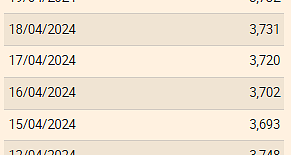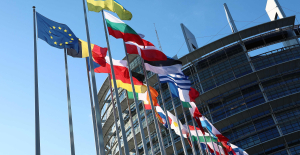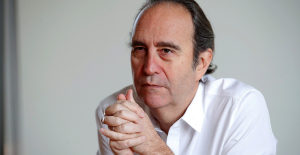Despite the recent turbulence in the banking sector, the US Federal Reserve is not going to be dissuaded from its fight against high inflation and is raising its key interest rate again by 0.25 percentage points. Now this is in the range of 4.75 to 5.0 percent, as the Federal Reserve (Fed) announced on Wednesday. It is the ninth increase in a row - but the US Federal Reserve is continuing its moderate course. In making its decision, the Fed had to weigh up the balance between calming concerns in the banking sector and fighting high consumer prices.
In the past year, the Fed raised the key interest rate by an impressive 0.75 percentage points several times, but recently slowed down and also opted for a small interest rate hike of 0.25 percentage points in February. Recent data shows that high inflation is on the wane in the world's largest economy.
The US Federal Reserve has now published new estimates of the inflation rate. It expects inflation to be slightly higher than previously assumed for the current year. The inflation rate is expected to average 3.3 percent. The medium-term inflation rate desired by the Fed is two percent – and the new figures are still a long way from that.
The Fed is also forecasting slightly lower economic growth for this year than assumed three months ago. The gross domestic product (GDP) of the world's largest economy will grow by 0.4 percent in 2023. That would be 0.1 percentage points less than forecast in December.
Before the decision was made, some experts had not even considered a pause in interest rate hikes to be out of the question given the problems in the banking sector. Fed Chairman Powell obviously didn't want to take this step after all - and so the Fed is instead showing its determination in the fight against high consumer prices. The decision-makers at the Fed expect the key interest rate to average 5.1 percent by the end of the year. An average of 4.3 percent is expected for 2024.
For the Fed, interest rate policy is a balancing act: it has to show that it takes the turbulence in the banking sector seriously - while at the same time not letting up in the fight against high consumer prices. High inflation in the USA is continuing to weaken. In February, US consumer prices increased by 6.0 percent compared to the same month last year. However, inflation is still too high.
The trigger for the banking crisis at the beginning of March was the liquidation of the US financial group Silvergate Capital, which is geared towards the crypto industry. A few days later, the US money house Silicon Valley Bank, which specializes in start-up financing, was placed under the control of the US deposit insurance company FDIC and closed. Other small banks stumbled. In Europe, the major Swiss bank Credit Suisse fell into the crisis.
"Kick-off Politics" is WELT's daily news podcast. The most important topic analyzed by WELT editors and the dates of the day. Subscribe to the podcast on Spotify, Apple Podcasts, Amazon Music, among others, or directly via RSS feed.

 The Euribor today remains at 3.734%
The Euribor today remains at 3.734% Germany: the trial of an AfD leader, accused of chanting a Nazi slogan, resumes this Tuesday
Germany: the trial of an AfD leader, accused of chanting a Nazi slogan, resumes this Tuesday New York: at Columbia University, the anti-Semitic drift of pro-Palestinian demonstrations
New York: at Columbia University, the anti-Semitic drift of pro-Palestinian demonstrations What is Akila, the mission in which the Charles de Gaulle is participating under NATO command?
What is Akila, the mission in which the Charles de Gaulle is participating under NATO command? What High Blood Pressure Does to Your Body (And Why It Should Be Treated)
What High Blood Pressure Does to Your Body (And Why It Should Be Treated) Vaccination in France has progressed in 2023, rejoices Public Health France
Vaccination in France has progressed in 2023, rejoices Public Health France Food additives suspected of promoting cardiovascular diseases
Food additives suspected of promoting cardiovascular diseases “Even morphine doesn’t work”: Léane, 17, victim of the adverse effects of an antibiotic
“Even morphine doesn’t work”: Léane, 17, victim of the adverse effects of an antibiotic MEPs validate reform of EU budgetary rules
MEPs validate reform of EU budgetary rules “Public Transport Paris 2024”, the application for Olympic Games spectators, is available
“Public Transport Paris 2024”, the application for Olympic Games spectators, is available Spotify goes green in the first quarter and sees its number of paying subscribers increase
Spotify goes green in the first quarter and sees its number of paying subscribers increase Xavier Niel finalizes the sale of his shares in the Le Monde group to an independent fund
Xavier Niel finalizes the sale of his shares in the Le Monde group to an independent fund Owner of Blondie and Shakira catalogs in favor of $1.5 billion offer
Owner of Blondie and Shakira catalogs in favor of $1.5 billion offer Cher et Ozzy Osbourne rejoignent le Rock and Roll Hall of Fame
Cher et Ozzy Osbourne rejoignent le Rock and Roll Hall of Fame Three months before the Olympic Games, festivals and concert halls fear paying the price
Three months before the Olympic Games, festivals and concert halls fear paying the price With Brigitte Macron, Aya Nakamura sows new clues about her participation in the Olympics
With Brigitte Macron, Aya Nakamura sows new clues about her participation in the Olympics Skoda Kodiaq 2024: a 'beast' plug-in hybrid SUV
Skoda Kodiaq 2024: a 'beast' plug-in hybrid SUV Tesla launches a new Model Y with 600 km of autonomy at a "more accessible price"
Tesla launches a new Model Y with 600 km of autonomy at a "more accessible price" The 10 best-selling cars in March 2024 in Spain: sales fall due to Easter
The 10 best-selling cars in March 2024 in Spain: sales fall due to Easter A private jet company buys more than 100 flying cars
A private jet company buys more than 100 flying cars This is how housing prices have changed in Spain in the last decade
This is how housing prices have changed in Spain in the last decade The home mortgage firm drops 10% in January and interest soars to 3.46%
The home mortgage firm drops 10% in January and interest soars to 3.46% The jewel of the Rocío de Nagüeles urbanization: a dream villa in Marbella
The jewel of the Rocío de Nagüeles urbanization: a dream villa in Marbella Rental prices grow by 7.3% in February: where does it go up and where does it go down?
Rental prices grow by 7.3% in February: where does it go up and where does it go down? Europeans: “All those who claim that we don’t need Europe are liars”, criticizes Bayrou
Europeans: “All those who claim that we don’t need Europe are liars”, criticizes Bayrou With the promise of a “real burst of authority”, Gabriel Attal provokes the ire of the opposition
With the promise of a “real burst of authority”, Gabriel Attal provokes the ire of the opposition Europeans: the schedule of debates to follow between now and June 9
Europeans: the schedule of debates to follow between now and June 9 Europeans: “In France, there is a left and there is a right,” assures Bellamy
Europeans: “In France, there is a left and there is a right,” assures Bellamy These French cities that will boycott the World Cup in Qatar
These French cities that will boycott the World Cup in Qatar Serie A: Bologna surprises AS Rome in the race for the C1
Serie A: Bologna surprises AS Rome in the race for the C1 Serie A: Marcus Thuram king of Italy, end of the debate for the position of number 9 with the Blues?
Serie A: Marcus Thuram king of Italy, end of the debate for the position of number 9 with the Blues? Milan AC-Inter Milan: Thuram and Pavard impeccable, Hernandez helpless… The tops and flops of the derby
Milan AC-Inter Milan: Thuram and Pavard impeccable, Hernandez helpless… The tops and flops of the derby Ligue 2: Auxerre leader, Bordeaux in crisis, play-offs... 5 questions about an exciting end of the season
Ligue 2: Auxerre leader, Bordeaux in crisis, play-offs... 5 questions about an exciting end of the season


















